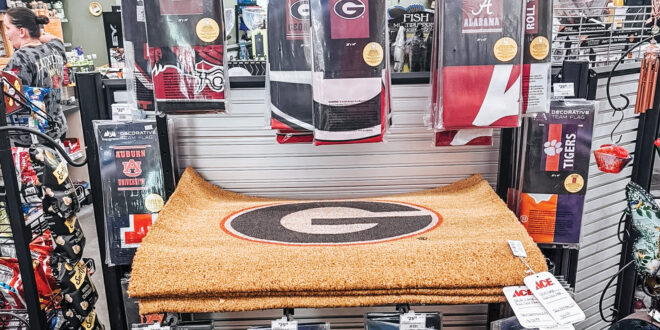The impulse category plays a subtle yet powerful role in boosting sales and enhancing the customer experience. These small, low-commitment items, often placed near checkout counters or high-traffic paths throughout stores, capitalize on customers’ spontaneous decisions.
When managed well, impulse products can build a store’s personality, drive repeat visits and even provide a sense of local flavor. Impulse items are typically inexpensive and ideal for quick purchases that don’t require much deliberation, but they still require a thoughtful strategy. A successful approach combines core staples, seasonal items and trending products, all supported by strategic merchandising and a willingness to pivot based on sales performance and shopper feedback.
Lean Into Local
Raven Beasley, manager of Grovetown Ace Hardware in Grovetown, Georgia, has built a thriving impulse program that reflects both her customers’ interests and her team’s input. The impulse section at Grovetown Ace Hardware is broad, offering everything from snacks and seeds to toys and quirky gifts, but reflects the store’s brand and focus on the community.
“A lot of local and regional sports team products do really well for us,” she says. “Each school switches their designs yearly, and we work with our sales reps to order the newest designs.”
Longtime staples at the store include air-powered salt shooters and carpenter bee traps—products that catch customers’ eyes and are practical.
The carpenter bee traps at Grovetown Ace Hardware, made locally and regularly delivered directly by the maker, have become a hit with customers. Finding partnerships in your community gives your store a local touch and shows that you support other independently owned businesses.
For Beasley, impulse category success isn’t just about keeping local favorites around—it also involves rotating out the underperformers.
“We give each new product around six months, and if it’s not selling, we’ll mark it down and see if it’ll sell then,” she says. “Usually, if we mark it down, it’ll sell. Those that don’t sell, we donate to a local charity.”
Give Impulse Prime Real Estate
Placing impulse products around the store is crucial for success in this category. The checkout counter is one of the most powerful areas of real estate in the store at Grovetown Ace Hardware.
“Our checkout counter is full of last-minute items and products people don’t usually think about right away,” Beasley says. “But if they see the product while they’re waiting to check out, that’s usually when they think about making a purchase.”
Endcaps and category-adjacent displays are two other strategic spots to consider showcasing impulse products. For example, Grovetown Ace Hardware merchandises garden signs near its outdoor living category, where customers are already in the mindset to buy these types of products.
While the store still works to improve consistency in this area of training, employees are taught and encouraged to mention impulse products during the checkout process, especially when items are seasonal or part of a limited-time display.
“This additional step can go a long way to increasing sales in the impulse category,” Beasley says.
Ask for Feedback
One of the most effective ways to discover new impulse products is by attending industry markets. Another way is through your employees. At Beasley’s store, younger team members have helped identify impluse products that resonate with their peers, such as trendy water bottle brands or fashion accessories, that have sold well in the store.
“We consistently talk with our younger employees about what they see trending in their worlds,” Beasley says. “We have brought in some of those products and several of them have done really well for us.”
Customer feedback is just as valuable. Grovetown Ace customers frequently recommend products or ask about items they’ve seen elsewhere, prompting Beasley to explore new additions to the store’s impulse category.
“We utilize our regular customers to help fill this category as well,” she says.
5 Best Practices for a Strong Impulse Category
- Rotate Regularly:
Give new products a set trial period and swap them out if they don’t perform.
- Leverage the Checkout Counter:
Make the most of the space where you have the chance to make a last-chance sale. Stock small, useful and attention-grabbing products.
- Mix Practical with Playful:
Offer a mix of products from fun gadgets and snacks to tools and seasonal decor.
- Get Input:
Offer a mix of products from fun gadgets and snacks to tools and seasonal decor.
- Pay Attention to Customer Feedback:
Shoppers will tell you, directly or indirectly, what they like. Listen and adjust accordingly.
Impulse Buying by the Numbers
- 80% of consumers shop impulsively in brick-and-mortar stores.
- 70% of consumers have impulsively bought an item because it was on sale.
- 36% of Americans say the majority of their purchases are unplanned.
- 35% of consumers say impulse purchases are driven by popular trends.
 Hardware Retailing The Industry's Source for Insights and Information
Hardware Retailing The Industry's Source for Insights and Information






